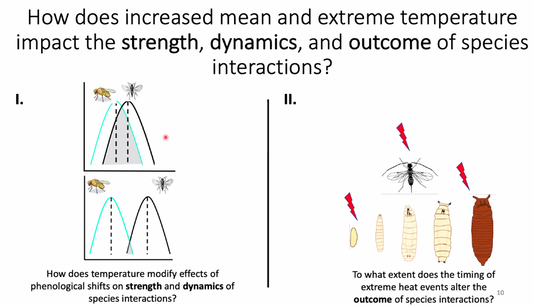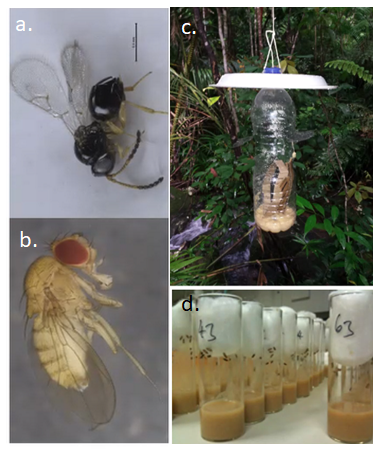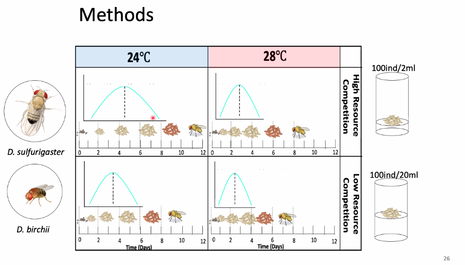|
by Taís Ribeiro and Max Ferlauto Climate change is having a drastic effect on species across the globe, our own included (Pachauri et al 2014). We have not only witnessed increases in mean temperatures but also extreme weather events like heat waves (Pachauri et al 2014). Although there are many studies looking at the impacts of climate change on particular species, research on the effects of climate change on species interactions is still limited. An important type of species relationship is a host-parasitoid interaction such as what occurs between an insect and its parasitoid wasp. Parasitoid wasps are tiny insects that lay their eggs in other insects. The eggs then hatch and consume the host while it is still alive. There are thousands of parasitoid wasp species. In fact, their order, Hymenoptera, may be the most diverse animal order in the world because of their high degree of specialization with their hosts (Forbes et al., 2018). In order to parasitize eggs, larvae, or pupae, parasitoids must align their life cycle with that of their hosts. But what happens when climate change increases temperatures and extreme climatic events? Does this misalign the host and parasitoid life cycles?  Figure 1. Main questions on how mean (I) and extreme (II) temperatures affect parasitoid systems. Figure 1. Main questions on how mean (I) and extreme (II) temperatures affect parasitoid systems. Dr. Nick Pardikes was intrigued by these overlooked questions and wanted to help investigate the impacts of climate change on ecological communities. He then pursued his interest, shifting from a professional baseball career, to start a PhD at the University of Nevada, Reno. He studied interactions between juniper trees, caterpillars, and parasitoids in the deserts of Southwestern USA (Pardikes et al 2018). However, opportunities brought him away from his beloved caterpillars and made him realize that sometimes pursuing a new study system can be very helpful for answering similar questions. As a postdoc in the Hrcek Lab in the Czech Academy of Sciences, he tried to answer questions about how climate change affects insect host-parasitoid interactions, performing experiments with a system involving fruit flies and parasitoid wasps (Figure 1). He presented this work in the spring seminar series at the University of Maryland Department of Entomology.  Figure 2. Study system and collection methods. a. Parasitoid wasp, b. Drosophila fly, c. banana-traps d. Study tubes. Figure 2. Study system and collection methods. a. Parasitoid wasp, b. Drosophila fly, c. banana-traps d. Study tubes. Fruit flies, in the genus Drosophila, have been an invaluable study system for research topics ranging from cancer to neurology. However, Dr. Pardikes was interested in their ecology. For a genus so well studied, there is relatively little known about the life of native species outside of the lab. Dr. Pardikes was interested in an understudied fruit fly-parasitoid wasp system native to the tropical rainforest of Queensland Australia, despite living and working thousands of miles away from there. So, he collected Drosophila flies and their parasitoid wasps using homemade banana traps (fruit flies love bananas!) in Australia. Then he flew them overseas back to his lab in the Czech Republic (Figure 2). In his lab, he investigated how increased mean temperature affected the strength and dynamics of the host-parasitoid interactions that become phenologically asynchronous. This work showed that temperature reduces the development time of the flies, as well as the successful emergence of the parasitoids that affect them (Pardikes et al, in prep.). Such changes to timing of important life history events, or phenological shifts, would mean that the emergence time for both interacting species are likely to change, and potentially become phenologically mismatched, so that fly larvae are no longer in their vulnerable stage for parasitism when the wasp is ready to lay eggs. By changing the temperature and food supply, Dr. Pardikes could experimentally prolong the growth of Drosophila larvae, inducing a four-day shift in the development (Figure 3)! Moreover, he noticed that the survival of the flies also increased as the emergence phenology of the parasitoid became increasingly delayed relative to its host, while the probability of parasitism decreased. This is likely because of an ontogenetic mismatch between host and parasitoid. The effects of phenological mismatch on fly survival varied depending on mean temperature and food availability. The effects of mismatch on parasitism rates also varied depending on food availability, but only at low temperatures. When modeling the system over many generations, having multiple host species help buffer parasitism rates from negative mismatch effects. In other words, even if some hosts shift out of a wasp species life cycle timing, there will likely be other species that can be parasitized instead. This suggests that species diversity can play an important role in dampening the conseqeunces of phenological shifts in ecological communities, and ongoing declines in insect diversity may exacerbate effects of phenological asynchrony.  Figure 3. Experiment for mean temperature changes in two Drosophila species. Increasing temperature and food availability lead to a faster development and growth. Figure 3. Experiment for mean temperature changes in two Drosophila species. Increasing temperature and food availability lead to a faster development and growth. Next, Dr. Pardikes looked at how extreme weather events, such as heat waves, impacted host survival and parasitism rates. He exposed the host-parasitoid interactions to a heat wave of 8°C above normal temperatures before, during, or after parasitism events. Then he measured the survival of the flies in each treatment relative to control vials without wasps. He found that neither the presence nor timing of the heatwave had an effect on fly survival. However, heat waves during and after parasitism events reduced parasitism rates. Interestingly, the heat wave’s effect on the parasitoids did not mirror the effects on the hosts. So, although heat waves had an immediate effect during parasitism, exposure to the fly during early development did not alter host-parasitoid interactions. Because parasitism rates are reduced under increased mean temperatures and extreme temperature events, parasitoid natural enemies may be less able to help regulate population dynamics of arthropod hosts in a warming world. This could lead to larger pest populations and more frequent or intense outbreaks. To extend this work, Dr. Pardikes is now developing dynamic models to explore ecological consequences for the timing of extreme heat events on stability of host-parasitoid interactions. There is still much research to be done before we can truly understand the effects of climate change in ecological networks. Dr. Pardikes’ experimental, observational and modeling research helps us understand these effects and answer some questions, not only regarding the specific Drosophila host-parasitoid system, but also in other ecological systems. References Forbes, A. A., Bagley, R. K., Beer, M. A., Hippee, A. C., & Widmayer, H. A. (2018). Quantifying the unquantifiable: why Hymenoptera, not Coleoptera, is the most speciose animal order. BMC ecology, 18(1), 1-11. https://doi.org/10.1186/s12898-018-0176-x Pachauri, R. K., Allen, M. R., Barros, V. R., Broome, J., Cramer, W., Christ, R., ... & van Ypserle, J. P. (2014). Climate change 2014: synthesis report. Contribution of Working Groups I, II and III to the fifth assessment report of the Intergovernmental Panel on Climate Change (p. 151). Ipcc Pardikes, N. A., Forister, M. L., & Dyer, L. A. (2019). Preference and performance of Lepidoptera varies with tree age in juniper woodlands. Ecological Entomology, 44(1), 140-150. Authors: Taís Ribeiro is a PhD student in the EspíndoLab and studies the ecology and evolution of South American oil-collecting bees. Max Ferlauto is a PhD student in the Burghardt Lab and studies the impacts of suburban leaf litter removal on overwintering insects. Comments are closed.
|
Categories
All
Archives
June 2024
|
Department of Entomology
University of Maryland
4112 Plant Sciences Building
College Park, MD 20742-4454
USA
Telephone: 301.405.3911
Fax: 301.314.9290
University of Maryland
4112 Plant Sciences Building
College Park, MD 20742-4454
USA
Telephone: 301.405.3911
Fax: 301.314.9290

 RSS Feed
RSS Feed




